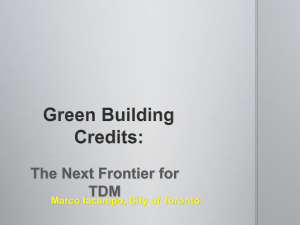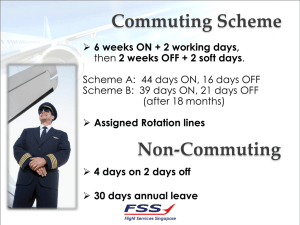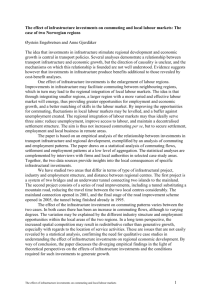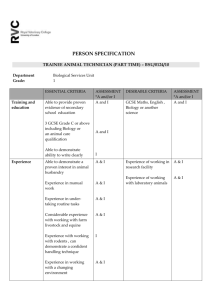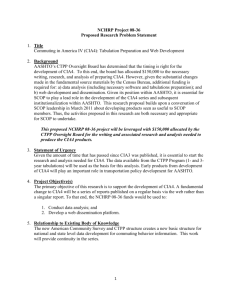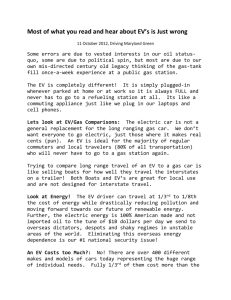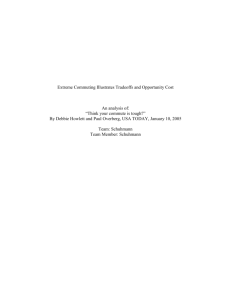Urban travel scales for analysing urban structure and evaluating
advertisement
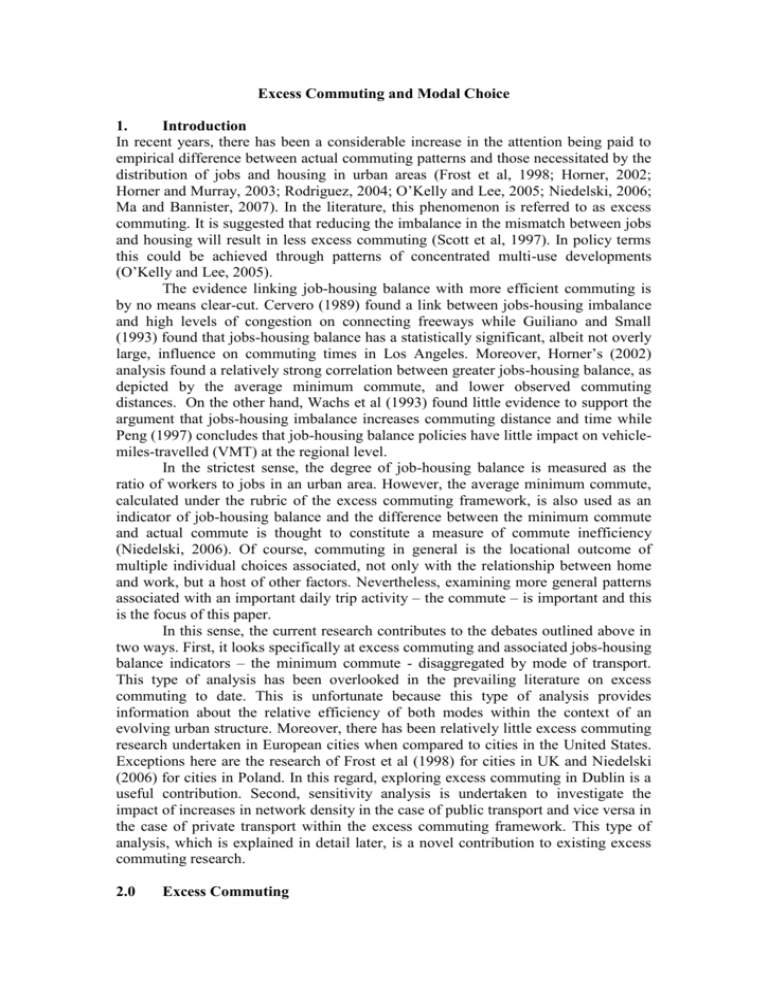
Excess Commuting and Modal Choice 1. Introduction In recent years, there has been a considerable increase in the attention being paid to empirical difference between actual commuting patterns and those necessitated by the distribution of jobs and housing in urban areas (Frost et al, 1998; Horner, 2002; Horner and Murray, 2003; Rodriguez, 2004; O’Kelly and Lee, 2005; Niedelski, 2006; Ma and Bannister, 2007). In the literature, this phenomenon is referred to as excess commuting. It is suggested that reducing the imbalance in the mismatch between jobs and housing will result in less excess commuting (Scott et al, 1997). In policy terms this could be achieved through patterns of concentrated multi-use developments (O’Kelly and Lee, 2005). The evidence linking job-housing balance with more efficient commuting is by no means clear-cut. Cervero (1989) found a link between jobs-housing imbalance and high levels of congestion on connecting freeways while Guiliano and Small (1993) found that jobs-housing balance has a statistically significant, albeit not overly large, influence on commuting times in Los Angeles. Moreover, Horner’s (2002) analysis found a relatively strong correlation between greater jobs-housing balance, as depicted by the average minimum commute, and lower observed commuting distances. On the other hand, Wachs et al (1993) found little evidence to support the argument that jobs-housing imbalance increases commuting distance and time while Peng (1997) concludes that job-housing balance policies have little impact on vehiclemiles-travelled (VMT) at the regional level. In the strictest sense, the degree of job-housing balance is measured as the ratio of workers to jobs in an urban area. However, the average minimum commute, calculated under the rubric of the excess commuting framework, is also used as an indicator of job-housing balance and the difference between the minimum commute and actual commute is thought to constitute a measure of commute inefficiency (Niedelski, 2006). Of course, commuting in general is the locational outcome of multiple individual choices associated, not only with the relationship between home and work, but a host of other factors. Nevertheless, examining more general patterns associated with an important daily trip activity – the commute – is important and this is the focus of this paper. In this sense, the current research contributes to the debates outlined above in two ways. First, it looks specifically at excess commuting and associated jobs-housing balance indicators – the minimum commute - disaggregated by mode of transport. This type of analysis has been overlooked in the prevailing literature on excess commuting to date. This is unfortunate because this type of analysis provides information about the relative efficiency of both modes within the context of an evolving urban structure. Moreover, there has been relatively little excess commuting research undertaken in European cities when compared to cities in the United States. Exceptions here are the research of Frost et al (1998) for cities in UK and Niedelski (2006) for cities in Poland. In this regard, exploring excess commuting in Dublin is a useful contribution. Second, sensitivity analysis is undertaken to investigate the impact of increases in network density in the case of public transport and vice versa in the case of private transport within the excess commuting framework. This type of analysis, which is explained in detail later, is a novel contribution to existing excess commuting research. 2.0 Excess Commuting Excess commuting (EC) is a measure of the extent to which the average actual commuting cost ( Tact ) in an urban area exceeds a theoretical average minimum commuting cost (Tmin ) where individuals are assumed to commute to their closest possible destination in terms of some measure of separation e.g. journey time or journey distance. It is described as the surplus commuting cost resulting from the fact that the actual geography of commuting deviates from the pattern that minimises commuting cost (Frost et al, 1998; Hamilton, 1982; Horner, 2002; White, 1988). That is, the surplus commuting cost resulting from the locational mismatch between jobs and housing (O’Kelly and Lee, 2005). The deviation between the mean actual commuting cost (Tact ) and the mean minimum commuting cost (Tmin ) can be expressed as a percentage: T (1) EC 1 - min *100 Tact Under the proposed framework, commuting is considered to be excess in the sense that it could, theoretically, be eliminated by swapping jobs and workplaces until commuting cost is minimised. Thus, policies aimed at promoting a greater jobshousing balance is thought to reduce the spatial disparities between jobs and housing thereby reducing the amount of commuting that is considered to be excess (Scott et al, 1997). Two main methodological streams dominate excess commuting research.1 The first is the original approach developed by Hamilton (1982). Hamilton used the assumptions of the classic monocentric urban model to predict actual and minimum commuting costs for a sample of fourteen and twenty-seven US and Japanese cities respectively concluding that almost 90% of urban commuting is excess or in his terminology ‘wasteful’. Hamilton (1989) admits that his results are biased upwards while his methodological approach has been challenged in subsequent research (White, 1988; Small and Song, 1992; Merriman et al, 1995; Horner, 2002). This leads to a discussion of the second approach. White (1988) uses a linear programming (LP) approach in order to take explicit account of the distribution of jobs and housing in 25 metropolitan areas in the United States finding that just over 10% of commuting to be excess. The LP approach determines the assignment of trips from homes to workplaces that minimises mean commuting cost: Min: Z = 1 m N i 1 n n s.t. cij Xij (2) j 1 Xij Dj j 1,..., m (3) i 1,..., n (4) i 1 m Xij Oi j 1 Xij 0 i, j (5) where, m = number of origins; n = number of destinations; Oi = trips beginning at zone i; Dj = trips destined for zone j; cij = travel cost from zone i to zone j; Xij = number of trips from zone i to zone j, and N = total number of trips. The objective function (2) minimises average transport costs. Constraint (3) ensures that trip 1 Both approaches are discussed here only briefly. A detailed account can be found in Ma and Bannister (2006). demand at each destination zone is satisfied while constraint (4) limits the number of trips leaving each origin zone to the number of trips originating there. Constraint (5) restricts the decision variables, Xij, to non-negative values. It should be noted that travel costs, cij, may be expressed in terms of any measure of zonal separation, for example travel distance, travel time or indeed a generalised cost measure. White’s method has been more widely adapted in excess commuting research in recent years (examples include Scott et al, 1997; Frost et al, 1998; Horner, 2002; Rodriguez, 2004; Niedelski, 2006; Ma and Bannister, 2007; Yang, 2008) while a number of significant extensions have been offered including a number of studies conducting disaggregate excess commuting analysis. These include Guiliano and Small (1993), Kim (1995), Horner (2002), Rodriguez (2004), O’Kelly and Lee (1995), Niedelski (2006) and Horner and Mefford (2007). Guiliano and Small (1993), for example, found that service workers have lower average minimum commute than technical workers while Horner (2002) found considerably different excess commuting values for males and females in a selection of US cities. Somewhat surprisingly, however, there has been little attempt to disaggregate excess commuting studies by mode of transport. A single exception is the recent work of Horner and Mefford (2007) that developed a conceptual approach synthesising research on spatial mismatch and jobs-housing balance, including disaggregation by mode of transport, within the broader applications environment of the excess commuting framework. Methodological extensions have also been offered. The main extensions include examining the sensitivity of excess commuting values to inclusion of longdistance commuters (Frost et al, 1998); to changes in the measure of zonal separation (Small and Song, 1992;); to modifiable aerial unit problem (MAUP) effects (Horner and Murray, 2002) while a number of authors have pointed towards the relative inability of the linear programming approach to deal with two-worker households (Kim, 1995; Buliung and Kanaroglou, 2002). On the conceptual side, there have also been significant extensions. For the current research, the most notable is the maximum commuting concept developed by Horner (2002) who uses the linear programming approach to maximise the cost of allocating individuals from homes to workplaces. In this regard, the objective function is the inverse of the minimisation problem discussed previously (2) and is given by: 1 m n (6) Max Z cijXij N i 1 j 1 where the constraints are identical to those of the minimisation problem (2-5). The maximum commute (Tmax ) can be interpreted as a worst case scenario where every individual in the study area commutes, on average, to the furthest possible workplace. Because the maximum commute is the inverse of the minimum commute, it has been interpreted (Horner, 2002) as a measure of possible jobs-housing imbalance. Together, the minimum and maximum commutes are, in Horner’s interpretation, indicative of a city’s commuting capacity. Thus, the extent to which commuters are utilising available capacity is seen as a indicator of commuting efficiency where lower value indicate greater efficiency and vice versa. Commuting capacity, Cu , is given by: T Tmin 100 (7) Cu act Tmax Tmin Other conceptual extensions, which are significant but are not the focus of the current research, include the introduction of the random commute (Hamilton, 1982; Charron, 2007) and the recent successful attempts by O’Kelly and Niedelski (2008a, 2008b) to integrate the excess commuting concept with that of entropy maximisation. 3.0 Study area and data 3.1 Dublin Prior to the late 1990s, Dublin was best characterised as having an essentially monocentric urban structure where the majority of employment was located in the city centre with scattered employment at the periphery (MacLaran, 1993; Murphy, 2004). Since the economic boom of the 1990’s, the landscape of Dublin’s built environment has changed dramatically. This period of prosperity has been characterised by industrial restructuring and in particular, a move towards more service-based industry (Williams and Shiels, 2002). A substantial proportion of this new service based employment has located in the suburbs while many older manufacturing industries have relocated to the outskirts. At the same time, rapid population increases fed a rapid acceleration in housing development and much of that development has occurred in a highly dispersed manner, giving rise to Dublin’s ‘edge city’ phenomenon (Williams and Shiels, 2002; MacLaran, 2005). Whereas in the past, Dublin was a relatively compact monocentric-like European city, it is now characterised by a sprawling urban hinterland. The foregoing changes in urban geography have been accompanied by a change in the geography of travel; specifically, they have created geographies of travel that have become increasingly complex and dispersed. Between 1991 and 2002, the proportion of individuals driving to work increased in all counties of the GDA with the greatest increases, in relative terms, occurred in the outlying counties (Murphy, 2006). Over the same period, the proportion of public transport trips decreased despite significant public transport investment. Thus, the revised pattern of journey to work flows appears to have placed a premium on car-based travel. 3.2 Data The study area covers a large portion of the Greater Dublin Area (GDA) (Figure 1). The data used in this study was derived from a Dublin Transportation Office (DTO) traffic simulation model for the 2001 peak period (8-9AM) and a comparable DTO model for the same period in 1991. The total number of trips recorded for 2001 was 327 001 while the corresponding figure for 1991 was 234 834. The model is based upon a 463 zonal sub-division of the Dublin Region which is derived from the Irish District Electoral Division (DED) system. The 1991 and 2001 data sets are based on the same zonal units. Three types of journey-to-work flow matrices were available for the peak period: (1) total trips, (2) car trips and (3) public transport trips (comprising bus and rail journeys). Similarly, road network distance commuting cost matrices were available for each mode of transport. Intra-zonal travel distances were estimated by assuming that each zonal unit is approximately circular in shape. Using this assumption and knowing the area of each zone (Ai), it was possible to calculate the radius of the circle, ri , which encloses that area from: ri Ai (8) Following previous studies (Frost et al, 1998; Horner, 2002), ri was taken to be the intra-zonal travel distance. The DTO data is based on a 463 zonal sub-division of the GDA. In a similar manner to other earlier studies, this study excluded those trips originating and destined for locations outside the study boundary. The impact of neglecting inward trips, in particular, on excess commuting measures has been highlighted by Frost et al (1998). While the exclusion of these trips is not ideal, the effect is likely to be limited for an urban area the size of Dublin. 4.0 Results The results presented herein are analysed first from the viewpoint of total trips and then for trips disaggregated by mode of transport. Turning to the former, Table 1 provides a breakdown of the results for 1991 and 2001. A number of points emerge. Table 1. Commuting Results for 1991 and 2001 – Total Trips It is immediately notable that values of Tmin have declined considerably over the study period. This indicates an increased inter-mixing of job-housing functions. This is due to the rapid decentralisation of employment that has occurred Dublin since 1991 (Williams and Shiels, 2000; Murphy, 2004). A number of scholars have suggested that promoting job-housing balance policies leads to a reduction in actual commuting costs (Cervero, 1989; Horner, 2002). One might expect, therefore, that a greater juxtaposition of employment and housing would lead to reductions in actual commuting cost in the study area. This is indeed the case. Values of Tact declined considerably (by 14.7%) but not proportionally to the decline witnessed for the value of Tmin (41.3%). Just over one-third (33.9%) of the reductions made possible by the increased inter-mixing is borne out in reductions in actual commuting. Nevertheless, the results appear to provide support for the hypothesis that a more balanced juxtaposition of jobs and housing contributes to a reduction in mean commuting costs. Values of Tmax have increased considerably over the period (by 19.2%). This is as expected given that greater inter-mixing of housing and employment, while allowing for a reduction in Tmin , also allows for an increase in Tmax (Horner and Mefford, 2007). Thus, the data shows that the commuting range ( Tmax – Tmin ) has increased sharply (by 39.2%) over the study period indicating that the greater intermixing of land use functions has facilitated a greater range of trip possibilities within the study area. The excess commuting results imply that commuting ‘efficiency’ has deteriorated over the period; values have increased by 12.4%. However, using excess commuting values as the sole means of indicating commuting efficiency can be misleading. A closer look at the data reveals that the reason for increased excess commuting is due to a greater proportional reduction in the value of Tmin than for Tact over the period. So even though actual commuting patterns have become more ‘inefficient’, as described by the excess commuting statistic, rather paradoxically, actual commuting costs have been reduced. It is notable that the values for 1991 are considerably higher than the city with the greatest level of excess commuting Manchester (54.7%) - found by Frost et al (1998) in their analysis of UK cities. This snapshot suggests that commuting efficiency was considerably worse in Dublin than in many UK cities at that time. When the Dublin data (for 1991) is compared with excess commuting values derived by Horner (2002) for US cities with a similar number of commute trips (for example Las Vegas, Omaha, Wichita) in 1990, it is evident that Dublin’s level of excess commuting is closer to these cities than to UK cities. This implies that commuting patterns that are closer, in terms of efficiency as described by the excess commute statistic, to similar sized cities in the United States. By way of contrast, capacity utilisation values decreased (by 13.6%) over the period suggesting ‘efficiency’ has increased. This is due to the increase in the commuting range over the period mentioned already. Nevertheless, this is one of the shortcomings of the efficiency measures proposed under the excess commuting framework: seemingly opposite conclusions can be drawn about the nature of commuting efficiency within the same city. This highlights the difficulty of drawing specific policy conclusions by referring to these statistics alone. Table 2. Commuting Results for 1991 and 2001 by mode of transport Table 2 shows commuting results broken down by mode of transport. In a similar manner to the aggregated results, a number of points emerge. First, it is clear that the evolution of land use patterns over the period has facilitated considerably more intermixing of jobs-housing functions for private transport users: values of Tmin declined by 104.5% for private transport users but by 35.1% for users of public transport. It appears that land use developments over the period have facilitated car users to a much greater extent. Indeed, in a general sense, the lower value of Tmin for car users indicates that users of this mode have access to employment opportunities closer to their place of residence than public transport. Given the extent of the reduction in Tmin for private transport one might logically expect Tact to have declined by a fairly similar extent. However, this is not the case. Values of Tact declined by 7.6% for public transport users but only by 19.6% for private transport users. In proportional terms, this suggests that the greater intermixing of jobs-housing function has enabled users of both modes to reduce Tact by approximately one fifth of that made available by reductions in Tmin . This is an interesting result because it suggests that a relatively small proportion of the reduction made available by greater inter-mixing is utilised in Tact . The results for Tmax are also of interest. The values are considerably higher for car users than for public transport users. This demonstrates the possibility for private transport users to travel longer commuting distances than public transport users. Obviously, this is related to the restrictions associated with the public transport network such as route and timetabling restrictions which limit the extent to which public transport users can take advantage of greater inter-mixing of employment and residential functions. However, the values of ( Tmax – Tmin ) reveal that while the range of available trip possibilities is considerably greater for private transport than for public transport – 22.1 kilometres as opposed to 12.8 kilometres (2001) - ( Tmax – Tmin ) has increased at a similar pace for public transport users (by 42.2%) as for private transport users (by 43.5%) over the period. This suggests that the greater intermixing of jobs-housing functions has certainly improved the range of trip possibilities offered to users of the public transport network. However, private transport users have benefited marginally more by this spatial reorganisation. If we turn once again to the excess commuting measures, two clear trends emerge: First, excess commuting values are considerably greater for private transport than for public transport. This points towards greater commute inefficiency for users of private transport. However, the foregoing should be viewed in conjunction with second trend which demonstrates a greater increase, 15.3% as opposed to 9.8% for private transport, in excess commuting measures over the study period. Thus, it appears that not only is excess commuting greater for private transport than for public transport, its relative inefficiency is increasing at a more rapid pace. A further point is to be made about the Cu measures; they have declined by 40.1% and 26.5% for private and public transport respectively over the course of the study period. Using Horner’s (2002) interpretation, this suggests that commuting patterns have become more efficient relative to the available commuting capacity. The reason for the decline is obvious from a cursory glance at the data: as alluded to earlier, the values of Tmax – Tmin have increased significantly for both modes while Tact – Tmin has increased only marginally. 5.0 Sensitivity Analysis Sensitivity analysis offers some useful possibilities for investigating the impact of alternative scenarios within the excess commuting framework. In this regard, public transport users are placed on the private transport network and vice versa with the following objectives: First, to investigate the impact of increases in network density in the case of public transport and vice versa in the case of private transport on the various solutions. Second, to examine the success or otherwise of policy rhetoric aimed at greater integration of land use and public transport - particularly in the case of public transport. The analysis was conducted for the 2001 data. Figure 1. Revised results after swapping networks (2001) Table 3. Savings and additions associated with swapping transport networks Figure 1 shows the revised results for Tmin , Tact and Tmax while Table 3 displays the commute savings and additions resulting from individuals using the alternative mode of transport. It is useful within the context of the objectives of our analysis, to discuss the results for each solution separately. Beginning in ascending sequence with the revised minimum solution, it is evident that public transport users are able to attain dramatic savings by using the private transport network while the opposite is the case for private transport users when placed on the public transport network. Undoubtedly, this is related to the greater density of the private transport network which allows its users to access employment opportunities closer to home. Most interesting however, is the fact that private transport users are able to minimise commuting costs on the public transport network to a greater extent than users of the public transport network. This is a counter-intuitive results and can hardly be taken as a ringing endorsement of the success of policy attempts to integrate land use and transportation in the Dublin area. The actual solutions present a similar trend although the relative commute savings and additions are not nearly as dramatic. The savings for public transport users on the private transport network are relatively consistent from the minimum to actual solutions. However, the cost additions placed on private transport users using the public transport network are considerably less for the actual solutions than for the minimum solutions, and in absolute terms are only marginally greater. In the context of actual commuting costs, this reinforces the central thrust of the point made earlier: private transport users are located more or less as advantageously to employment opportunities along the public transport network as public transport users. While undoubtedly this is counter-intuitive it nevertheless elucidates the advantageous nature of the private transport network – in terms of its relative ubiquity - over the public transport network. The most interesting result to emerge from the maximum solutions is the fact that the maximum journey distance increases for public transport users on the private transport network and decreases for private transport users on the public transport network. Indeed, the revised range of trip possibilities ( Tmax – Tmin ) shows a similar trend further highlighting the inability of the public transport network to deal adequately with the range of trip possibilities offered by the extent of the city’s urban structure. With regard to the efficiency measures, excess commuting values increase marginally for public transport users commuting on the private transport network (from 59.8% to 61.1%) while capacity utilisation measures decrease considerably (from 43.0% to 32.9%). The opposite trend emerges when private transport users are placed on the public transport network; excess commuting declines from 78.4% to 71.2% while capacity utilisation increases from 36.2% to 38.1%. Of these results, it is noteworthy that excess commuting, in particular, declines when restrictions are placed on the extent of the transport network. Thus, increasing the range of trip possibilities would appear to support greater excess commuting. 6.0 Conclusions Some specific conclusions can be delineated from the foregoing results. First, the central focus of the paper has been to provide disaggregate modal choice analysis of journey-to-work patterns within the existing excess commuting framework. The results show that excess commuting is considerably greater for private transport users implying that mode is less efficient than public transport. However, this needs to be viewed within the context of the capacity utilisation measures ( Cu ) which show that private transport users have used less available commuting capacity than public transport users and, in this sense are more efficient. Thus, the internal contradictions within the excess commuting framework would appear to point towards the inadequacy of these measures, on their own, for judging commuting efficiency. What is of greater interest from the point of view of commuting efficiency is the values of Tmin , Tact and Tmax , and particularly how they change over time, which has more specific relevance to policy issues. Second, the sensitivity analysis offers some useful possibilities for investigating the impact of increases network density in the case of public transport and vice versa in the case of private transport. It also provides some indication, particularly in the case of public transport, of the success or otherwise of policy rhetoric aimed at greater land use and public transport integration. So in the case of Dublin for example the results show that public transport users could achieve dramatic savings if the density of that network was increased to bring it closer in line with the trip possibilities offered by the private transport network. Of course, this not a simple task and requires significant financial investment. Nevertheless, it has significant potential to enter the policy-making arena. Moreover, the results for Dublin also indicate, quite dramatically, that policy rhetoric aimed at integrating land use with public transport functions has been rather unsuccessful in the following sense: private transport users are afforded the possibility of minimising commuting costs on the public transport network to a greater extent than the rightful users of that network. That is, private transport users live closer to their workplace regardless of what network they use, implying the relative lack of success at integrating land use and transport for users of public transport. Finally, and more broadly, the results suggest that the decentralisation of employment and the resultant greater inter-mixing of jobs-housing functions facilitates a reduction in actual commuting costs. Furthermore, inter-mixing also appears to facilitate an increase in the range, and doubtless too, the complexity, of trip possibilities. The implications of these trends can only be inferred but a relatively robust assertion can be made: all else being equal, any increase in the complexity of commuting patterns is likely to place private transport at a distinct advantage over public transport, which in the case of Dublin, attests to the relative decline in the use of public transport for the morning commute over the study period. It is wellestablished that public transport systems work best when serving a limited number of routes with high traffic volumes (MacLaran and Killen, 2002). Thus, as the complexity of commuting increases, the role played by public transport in servicing revised patterns of trip making will be undermined unless significant improvements are made to the density of that network. The task for the future then, it seems to me, is not only to concentrate on improving integration of land use and public transport systems – which in the case of Dublin at least is wholly inadequate - but also to actively pursue increases in the density of the public transport network to more adequately serve a wider and more complex range of commuting possibilities. References Buliung, R., Kanaroglou, P. S., 2002. Commute minimisation in the Greater Toronto Area: applying a modified excess commute. Journal of Transport Geography 10, 177186. Cervero, R., 1989. Jobs-housing and regional mobility. Journal of the American Planning Association 70, 269-281. Charron, M., 2007. From excess commuting to commuting possibilities: more extension to the concept of excess commuting. Environment and Planning A 39, 1238-1254. Frost, M., Linneker, B., Spence, N., 1998. Excess or wasteful commuting in a selection of British cities. Transportation Research A 32, 529-538. Giuliano, G., Small, K.A., 1993. Is the journey to work explained by urban structure? Urban Studies 30, 1485-1500. Hamilton, B.W., 1982. Wasteful Commuting. Journal of Political Economy 90, 10351053. Hamilton, B.W., 1989. Wasteful Commuting Again. Journal of Political Economy 97, 1497-1504. Horner, M.W., 2002. Extensions to the concept of excess commuting. Environment and Planning A 34, 543-566. Horner, M.W., Mefford, J.N., 2007. Investigating urban spatial mismatch using jobshousing indicators to model home-work separation. Environment and Planning A 39, 1420-1440. Horner, M.W., Murray, A.T., 2002. Excess commuting and the modifiable areal unit problem. Urban Studies 39, 131-139. Kim, S., 1995. Excess commuting for two-worker households in the Los Angelus metropolitan area. Journal of Regional Science and Urban Economics 38, 166-82. Ma, K-R., Bannister, D., 2006a. Extended excess commuting: A measure of the jobshousing imbalance in Seoul. Urban Studies 43, 2099-2113. Ma, K-R., Bannister, D., 2006b. Excess commuting: a critical review. Transport Reviews 26, 749-767. MacLaran, A., 1993. Dublin: the shaping of a capital. Belhaven, London. MacLaran, A., Killen, J.E., 2002. The suburbanisation of office development in Dublin and its transport implications. Journal of Irish Urban Studies 1, 21-35. MacLaran, A., 2005. Suburbanising Dublin: out of an overcrowded frying pan into a fire of unsustainability? In Moore, N., Scott, M., (Ed.), Renewing urban communities: environment, citizenship and sustainability in Ireland, Ashgate, Aldershot pp. 60-74. Merriman, D., Ohkawara, T., Suzuki, T., 1995. Excess commuting in the Tokyo metropolitan area: measurement and policy simulations. Journal of urban Economics 38, 7-23. Murphy, E., 2004. Spatial Restructuring and Commuting Efficiency in Dublin. Journal of Irish Urban Studies 3, 25-38. Murphy, E., 2006. On constructing urban travel scales for analysing daily travel patterns: the case of the Greater Dublin Area, Ireland. Unpublished Ph.D thesis, Department of Geography, Trinity College Dublin. Niedzielski, M.A., 2006. A spatially disaggregated approach to commuting efficiency, Urban Studies 43, 2485-2502. O’Kelly,M.E., Lee, W., 2005. Disaggregate journey-to-work data: implications for excess commuting and jobs-housing balance. Environment and Planning A 37, 22332252. O’Kelly, M.E., Niedelski, M.A., 2008a. Efficient spatial interaction: attainable reductions in metropolitan average trip length. Journal of Transport Geography 16, 313-323. O’Kelly, M.E., Niedelski, M.A., 2008b. Spatial interaction models for excess commuting studies. Paper presented at the Annual Association of American Geographers, Boston, April. Peng, Z-R., 1997. Jobs-housing balance and urban commuting. Urban Studies 34, 1215-1235. Rodriguez, D.A., 2004. Spatial choices and excess commuting: a case study of bank tellers in Bogota, Columbia. Journal of Transport Geography 12, 49-61. Scott, D.M., Kanaraglou, P.S., Anderson, W.P., 1997. Impacts of commuting efficiency on congestion and emissions: case of the Hamilton CMA, Canada. Transportation Research D 2, 245-57. Small, K.A., Song, S., 1992. Wasteful Commuting: A Resolution. Journal of Political Economy 100, 888-898. Wachs, M., Taylor, B.D., Levin, N., Ong, P. 1993. The changing commute: a casestudy of the jobs-housing relationship over time. Urban Studies 30, 1711-1729. White, M.J., 1988. Urban commuting journeys are not “Wasteful”. Journal of Political Economy 96, 1097-1110 Williams, B., Shiels, P., 2000. Acceleration into Sprawl: Causes and Potential Policy Responses. Quarterly Economic Commentary. Dublin: Economic and Social Research Institute Williams, B., Shiels, P. 2002. The Expansion of Dublin and Policy Implications of Dispersal. Journal of Irish Urban Studies 1, 1-19. Yang, J., 2008. Policy implications of excess commuting: Examining the impacts of changes in US metropolitan spatial structure. Urban Studies 45, 391-405. Figure 1. Revised results after swapping networks (2001) 25 24.3 22.4 20 17.3 16.5 15 Min Max 10 10.4 10.2 9.2 Actual 7.7 5 3.7 3 3 2.2 0 PT Users on PT PT Users on Car Car Users on Car Car Users on PT Network RND (Kms) Network RND (Kms) Network RND (Kms) Network RND (Kms) Table 1. Commuting Results for 1991 and 2001 – Total Trips EC CU Tact Tmax Tmin 1991 4.6 11.6 18.2 60.3% 51.5% 2001 2.7 9.9 21.7 72.7% 37.9% Table 2. Commuting Results for 1991 and 2001 by mode of transport EC CU Tact Tmax Tmin PrvT 1991 2001 PubT 1991 2001 4.5 2.2 12.2 10.2 19.7 24.3 63.1% 78.4% 50.7% 36.2% 5.0 3.7 9.9 9.2 14.0 16.5 50.0% 59.8% 54.4% 43.0% Table 3. Savings and additions associated with swapping transport networks Public transport users on private transport network add 4.9% Maximum Solution Private transport users on public transport network save 7.8% Actual Solution Public transport users on private transport network save 16.3% Private transport users on public transport network add 2.0% Minimum Solution Public transport users on private transport network save 18.9% Private transport users on public transport network add 36.4%

